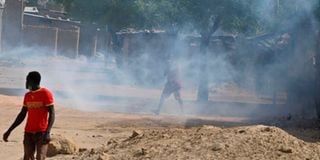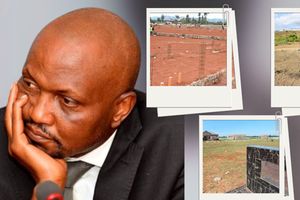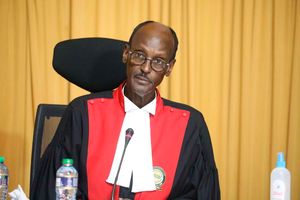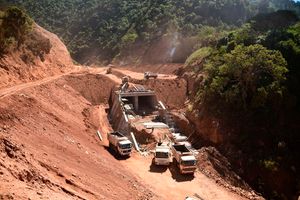Premium
Prophetic poetry and majestic guns of the Chadian liberators

Smoke billows from burning tyres during clashes between opposition demonstrators and Chadian police in N’Djamena on April 27, 2021.
Can poetry, or verse, foretell the future? Since I am an obviously interested party, I will not rush into a yes or no answer. Rather, let me start by sharing with you a piece of verse that I wrote just over 30 years ago. I called it “Chad ‘90”, and I present it here in two paragraphs of “prose”, just to cheat the editor. Here we go.
“We’re free, we’re saved again. We ought to cheer and dance, embrace our grimy ‘boys’ and sing our leader’s praise. We thank and welcome your Gunjesty. But, sir, we’re sick and tired and hungry. There are corpses awaiting burial.
“A saviour every year can easily break a looted, raped people’s soul. Every liberation leaves fewer and fewer of us. When the next saviour comes, as surely he will, our bones may be the only welcome he gets.”
The inspiration for the piece was obviously Chad, the Sahel country where they had presidential elections recently. Then President Idriss Deby, who had just won a sixth term in a row, goes and gets himself killed in a battle with rebels seeking to overthrow him. But it was the circumstances of his original coming to power, as a guerrilla leader, that inspired my piece of verse.
Idriss Deby came to power in 1990 after overthrowing Hissene Habre, who had seized power from Goukouni Oueddei, in an apparently unending cycle of coups and rebel putsches, each dubbed a “liberation”. Hissene Habre, as you know, fled, with a huge sum of money from Chad’s coffers, to Senegal, where he was eventually arrested, tried and convicted on charges of crimes against humanity. The question is where do these shenanigans, not uncommon in other African countries, leave us ordinary wananchi?
Literary creator
This brings us to the role of the literary creator in the affairs of her or his people. We are not “prophets of doom”, as some political hawks were wont to label us in those difficult days when everything that smacked of “Ngugi”, socialism or revolution had to be kept out of the reach of children. Rather, because we closely observe the realities around us and reflect profoundly on them, we are likely to read and accurately foresee the outcomes of human behaviour.
Unfortunately, we are often Cassandras. In Greek orature, Cassandra was the brilliant woman gifted with the ability to forecast events. When, however, she turned down the advances of the prophecy divinity, Apollo, her predictions were blighted with the curse that they would never be believed, despite their infallible accuracy. Will Africa and its leaders, for once, change tack and listen to its imaginative and creative communicators, and believe them?
Do you remember my telling you, some four years ago, of a piece I wrote about “A Twit on Twitter”? Well, a twit is an absolute idiot, and I need not remind you of what transpired before the end of the four years with my imaginative (but not imaginary) character on Twitter.
I dare not try any new verses or prophecies about Chad, or the Sahel in general. It is a rather sad region anyway, stretched out across the southern end of the Sahara, from the Atlantic Ocean to the Red Sea. Its people, in countries like Mauritania, Senegal, Burkina Faso, Mali Niger, Chad and Sudan, are permanently threatened by the expanding desert and now increasingly by fanatical murderers perverting religious fervour for their own nefarious ends.
Great Green Sahel Wall
The best story I have heard from the Sahel is that of the Great Green Sahel Wall. This is the grand African project to plant and tend a forest, at least fifty kilometres thick, right across the region between the southern borders of the Sahara and the northern reaches of all the Sahel countries.
If properly undertaken and executed, this project, activated in 2002 in Ndjamena, the Chadian capital, and approved by the African Union in 2007, would create an ecological and climatic buffer zone between the Sahara and the semi-arid lands of the Sahel states.
This is a dream and an aspiration that I would certainly love to see fulfilled. I would gladly prophesy that it can and will come true. Will I, however, be believed? Wouldn’t those axe-wielding and chainsaw-churning vandals rather argue that it is easier to join our own green lands to the Sahara than keep it off with a barrier? Still, I dare to hope and trust that Africa will plant and grow the Great Green Wall, and those who bring it to reality will stand tall among our true liberators.
Liberation
Still thinking of liberation and liberators, I noted that Tanzania and Uganda signed their oil pipeline agreement on April 9 this year. This is the same day of the month, 42 years ago, when Ugandan guerrillas, backed by Tanzanian forces, captured Kampala and drove Idi Amin out of Uganda.
Ugandans often refer to the event as their “first liberation”, and it is one of the reasons for the deeply entrenched solidarity between Uganda and Tanzania. It may have been coincidence, but I think there was some historical significance to President Samia Suluhu Hassan’s choice of her first state visit, to Uganda, on April 9.
I looked even further back, to our 1960s undergraduate days, as I watched Ndugu Museveni exchange respectful pleasantries with President Samia Hassan. Tanzania’s long-term investments, in our Dar education and the assistance to our liberators, seems to be finally paying dividends.
Incidentally, Kenya Tanzania and Uganda are directly involved in the Great Green Wall. The Intergovernmental Authority on Development in Eastern Africa (IGAD), of which we are key members, is a major partner in the project. In any case, the final eastern trees of the Wall may jolly well be in Djibouti, where IGAD is headquartered.
Are these not uplifting thoughts as we enter May, our traditional tree-planting month?





